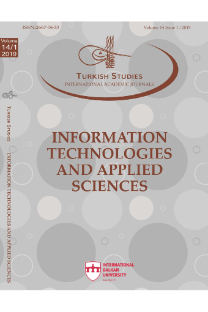SANAL GERÇEKLİK TEKNOLOJİSİYLE İŞLENEN TARİH METODOLOJİSİ DERSİNİN ÖĞRENCİ ALGISINA ETKİLERİ
THE IMPACTS OF THE COURSE OF HISTORICAL METHODOLOGY THAT IS CONDUCTED BY VIRTUAL REALITY TECHNOLOGY ON THE PERCEPTIONS OF THE STUDENTS
___
- Anderson, C. ve Moore, A., (1994). “Making History Happen Outside The Classroom”, Teaching History, London and New York: Routledge,, ss. 196-208.
- Akbaba, B. (2014). “Tarih Öğretiminde Görsel Kaynaklardan Yararlanma”, Tarih Nasıl Öğretilir?. (Ed.: Mustafa Safran), 3. Baskı, Ankara: Yeni İnsan Yayınevi, ss. 217-230.
- Akkoyunlu, B. (1995). “Bilgi Teknolojilerinin Okullarda Kullanımı ve Öğretmenlerin Rolü”, Hacettepe Üniversitesi Eğitim Fakültesi Dergisi, 11, Ankara, ss. 105-109.
- Akkuş, A. ve Meydan, A. (2013). “Sosyal Bilgiler Öğretiminde Tarihi ve Coğrafi Mekân Uygulamalarının Değerlendirilmesi”, Uluslararası Avrasya Sosyal Bilimler Dergisi, 4 (13), ss. 14-30.
- Alay, R. (2004). “Küreselleşme, Bilgi Toplumu ve Eğitim”, Ankara Üniversitesi Eğitim Bilimleri Fakültesi Dergisi, 37(2), Ankara, ss. 61-82.
- Avcı, C. ve Öner, G. (2015). “Tarihi Mekânlar İle Sosyal Bilgiler Öğretimi: Sosyal Bilgiler Öğretmenlerinin Görüş ve Önerileri”, Abant İzzet Baysal Üniversitesi Eğitim Fakültesi Dergisi, (USBES Özel Sayısı I), 15, ss. 108-133.
- Baştürk, R. (2009). “Bilimsel Araştırma Yöntemleri”, Deneme Modelleri, (Ed.: A. Tanrıöğen), Ankara: Anı Yayıncılık, ss. 29-54.
- Bilgin, B., ve Selçuk, M. (1997). Din Öğretimi Özel Öğretim Yöntemleri, Ankara: Gün Yayıncılık.
- Büyüköztürk, Ş., Çakmak, E. K., Akgün, Ö. E., Karadeniz, Ş. ve Demirel, F. (2010). Bilimsel Araştırma Yöntemleri, Ankara: Pegem Akademi,.
- Carr, E. H. (1961). What is History?, Stuttgart: Published by Mcmillan
- Christensen, L. B., Johnson, R. B. ve Turner, L. A. (2015). Araştırma Yöntemleri Desen ve Analiz, (Çev. Ed.: Ahmet Alpay), 2. Baskı, Ankara: Anı Yayıncılık.
- Çığır Dikyol, D., İnce, E. ve Usta, S. (2011). “Öğretmen Adaylarının Tarihi Mekânlara ve Eserlere İlişkin Görüşlerinin İncelenmesi”, Hasan Ali Yücel Eğitim Fakültesi Dergisi, 16 (2011-2), ss. 57-68.
- Demir, R. (2017). Beyin Temelli Öğrenme Yaklaşımına Dayalı Din Öğretimi, Adana: Karahan Kitabevi.
- Demir, R. (2019). “Sanal Gerçeklik Gözlüğüne Dayalı Din Öğretimine Yönelik Öğretmen Adaylarının Tutumu”, Manas Sosyal Araştırmalar Dergisi, 8 (1/2), ss. 867-881.
- Demircioğlu, İ. H. (2005). Tarih Öğretiminde Öğrenci Merkezli Yaklaşımlar, Ankara: Anı Yayıncılık.
- Erbaş, Ç. ve Demirer, V. (2014). “Eğitimde Artırılmış Gerçeklik Uygulamaları: Google Glass Örneği”, Journal of Instructional Technologies & Teacher Education, 3 (2), ss. 8-16.
- Gökberk, M. (2011). Değişen Dünya Değişen Dil. (Ed.: Elif Gökteke), 7. Baskı, İstanbul: YKY.
- Gömleksiz, M. N. ve Bulut, İ. (2007). “Yeni Fen ve Teknoloji Dersi Öğretim Programının Uygulamadaki Etkililiğinin Değerlendirilmesi”, Hacettepe Üniversitesi Eğitim Fakültesi Dergisi, 32, ss. 76-88.
- Gökkaya, A. K. ve Yeşilbursa, C. C. (2009). “Sosyal Bilgiler Öğretiminde Tarihi Yerlerin Kullanımının Akademik Başarıya Etkisi”, Türk Eğitim Bilimleri Dergisi, 7 (2), ss. 483-506.
- Gümüşçü, O. (2018). Kaynaklarıyla Tarihî Coğrafya. İstanbul: Yeditepe Yayınevi.
- Heim, M. (1993). The Metaphysics of Virtual Reality, New York: Oxford University Press.
- Kaleci, D., Tepe, T., Tüzün, H. (2017). “Üç Boyutlu Sanal Gerçeklik Ortamlarındaki Deneyimlere İlişkin Kullanıcı Görüşleri”, Türkiye Sosyal Araştırmalar Dergisi, 21 (3), ss. 669-689.
- Karasar, N. (1999). Bilimsel Araştırma Yöntemi, Ankara: Nobel Yayın Dağıtım.
- Korkmaz, M. (2014). Din Öğretimi Teknolojisi ve Materyal Geliştirme, Kayseri: Tezmer Yay. Köstüklü, N. (1998). Sosyal Bilimler ve Tarih Öğretimi, Konya: Kuzucular Ofset.
- Kütükoğlu, M. S. (2011). Tarih Araştırmalarında Usûl, Ankara: TTK Yayınları.
- Ökse, A. T. (1998). “Yukarı Kızılırmak Havzası Tunç Çağları ve Demir Çağı Yerleşim Tarihi”, Belleten, LXII/234, Ankara: TTK Yayınları, ss. 299-355.
- Özdemir, Ş. ve Çelik, R. (2017). “Din Kültürü ve Ahlak Bilgisi Dersi Tutum Ölçeğinin Geçerlik ve Güvenirlik Çalışması”, Amasya Üniversitesi İlahiyat Fakültesi Dergisi, 4 (8), ss. 7-20.
- Özmen, H. (2004). “Fen Öğretiminde Öğrenme Teorileri ve Teknoloji Destekli Yapılandırmacı (Constructivist) Öğrenme”, The Turkish Online Journal of EducationalTechnology (TOJET), 3 (1), ss. 1303-6521.
- Öztürk, M. (2014). “Mekânı Algılama Becerisi”, Tarih Nasıl Öğretilir?. (Ed.: Mustafa Safran), 3. Baskı, Ankara: Yeni İnsan Yayınevi, ss. 104-115.
- Sarıkoç, G. (2016). “Sağlık Çalışanlarının Eğitiminde Sanal Gerçekliğin Kullanımı”, Hemşirelikte Eğitim ve Araştırma Dergisi, 1 (13), ss. 243-247.
- Selvi, Ö. (2012). “Bilgi Toplumu, Bilgi Yönetimi ve Halkla İlişkiler”, Gümüşhane Üniversitesi İletişim Fakültesi Elektronik Dergisi, 3, ss. 191-214.
- Sherman, W. R., Craig A. B. ve Will, J. D. (2009). Developing Virtual Reality Application: Foundation Of Effective Design, China: Morgan Kaufmann Publication.
- Tepe, T, Kaleci, D. ve Tüzün, H. (2016). “Eğitim Teknolojilerinde Yeni Eğilimler: Sanal Gerçeklik Uygulamaları”, 10th International Computer and Instructional Technologies Symposium (ICITS), 16-18 May 2016-Rize, ss. 547-555.
- http://www.3dmekanlar.com/tr/halep-kalesi.html, E.T.: 20/03/2019, 15:00.
- ISSN: 2667-5633
- Yayın Aralığı: 4
- Başlangıç: 2006
- Yayıncı: ASOS Eğitim Bilişim Danışmanlık Otomasyon Yayıncılık Reklam Sanayi ve Ticaret LTD ŞTİ
DİJİTAL HİKAYE ANLATIMI: İÇERİK ÜRETİCİLERİNİN YOUTUBE VİDEOLARI ÜZERİNDEN BİR ANALİZ
DİJİTAL OYUN BAĞIMLILIĞININ NARSİSİZM KÜLTÜRÜNE ETKİLERİ
UYARLANABİLİR ÖĞRENME SİSTEMLERİNDE KULLANICI VERİLERİ
Neslihan ADEMİ, Suzana LOSHKOVSKA
BIG DATA USAGE IN INTERNET ADVERTISING
İbrahim ATEŞ, Esra Ayça GÜZELDERELİ YILMAZ, Aslıhan TÜFEKÇİ
USER DATA IN ADAPTIVE LEARNING SYSTEMS
Neslihan ADEMİ, Suzana LOSHKOVSKA
İNTERNET REKLAMCILIĞINDA BÜYÜK VERİ KULLANIMI
Aslıhan TÜFEKCİ, İbrahim ATEŞ, Esra Ayça GÜZELDERELİ YILMAZ
TEKNOLOJİK GELİŞMENİN İSTİHDAM ÜZERİNDEKİ ETKİLERİ: TÜRKİYE ÖRNEĞİ
ÖĞRENCİLERİN TASARIM BECERİLERİNİN DEĞERLENDİRİLMESİ: 3B TASARIM DERSİ ÖRNEĞİ
ERHAN ŞENGEL, Faysal KOÇAK, Barış Gökhan GÜLERYÜZ
SANAL GERÇEKLİK TEKNOLOJİSİYLE İŞLENEN TARİH METODOLOJİSİ DERSİNİN ÖĞRENCİ ALGISINA ETKİLERİ
